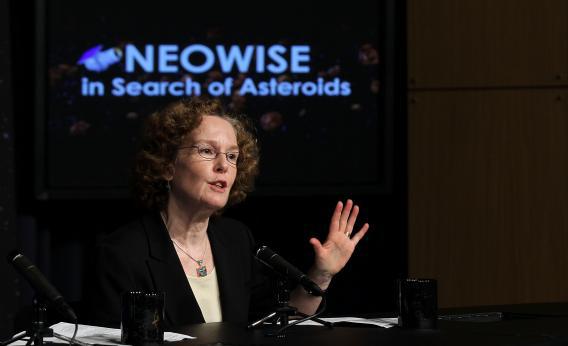About midafternoon Friday (Eastern time), a 160-foot asteroid known as 2012 DA14 will whip by the Earth, 17,000 miles (27,000 kilometers) above the Earth’s surface. As Phil Plait wrote earlier this week in Slate, the asteroid poses no danger to anyone—its trajectory is well known, and it will miss the Earth. But it “poses no danger” in the same way that a gun fired a half-inch above your head does. If you were absolutely certain of the trajectory of the bullet (which, in this case, we are) and knew that it wouldn’t hurt anyone else nearby, and there was nothing you could to stop it anyway, you could be comfortable in the knowledge that it would not affect you at all. But it doesn’t make much sense to ignore the shot entirely. (Update, Feb. 15: This morning, before 2012 DA14’s fly-by, another bullet shot even closer. This time, a meteor lit up Russia’s skies, underscoring the danger space rocks could pose. For more, read Phil Plait’s coverage on Bad Astronomy.)
Impacts of large asteroids on Earth are rare. Asteroids the size of tomorrow’s would cause only localized damage. The orbits of larger objects are better known, and so imminent danger of mass extinction is low. It is unlikely that astronomers will soon discover a “potentially hazardous asteroid” (PHA) high on what astronomers have dubbed the Torino scale. Still, NASA is not doing nearly enough to prepare for that unlikely eventuality.
What should be NASA’s most important task—keeping the Earth, and America, safe from asteroid and comet impact—is barely mentioned in its latest strategic plan, released earlier this week. Planning for a mission to deflect a potential cataclysm is left to private organizations like the B612 Foundation, in which a number of engineers and scientists with years of experience with NASA are involved. It’s even headed by former astronaut Ed Lu. But this is too important a task to be left to philanthropists and retirees like the B612 crowd. However laudable their efforts, they lack the resources and capability that the government has. Keeping its citizens safe is the foundational responsibility of government. And in this respect, NASA has been heedless of its responsibilities.
Yes, the risk of impact is low. (More on how low in a minute.) However, the U.S. government spends plenty of money guarding against the prospect of other low-probability events. Despite evidence that full-body scanners neither work as well, nor are as safe, as claimed, the TSA has spent hundreds of millions of dollars on them, against the low probability that someone would try and smuggle something nefarious onto an airplane that previous security measures would have missed. The Defense Threat Reduction Agency in the Pentagon, the National Nuclear Security Administration in the Department of Energy, and the Department of Homeland Security’s Domestic Nuclear Detection Office, among other government agencies, collectively spend billions annually countering the very low-probability event of nuclear terrorism. None of these events, however horrific, have the potential to cause damage on the scale that a celestial body impacting Earth could. (Only a full-scale nuclear war with Russia might approach the damage of a large asteroid, and that’s not what the billions spent on radiation scanners at container ports, and similar measures, are meant to avert.)
It is far easier to quantify the risk from asteroids that have already been tracked than from something as nebulous as terrorism. The Near Earth Object Program at NASA’s Jet Propulsion Laboratory is doing an admirable job of estimating impact risk of currently known PHAs. But there are also the unknown unknowns. A report last year from NASA estimated that only 20 to 30 percent of PHAs have been found. It is entirely possible that tomorrow, or next year, or five years from now, an astronomer will find an object on a collision course with Earth.
However, if we have learned anything in the past several decades of space operations, it is that it is extremely difficult to throw together something at the last minute. Developing all of the technological infrastructure for something like a gravitational tractor will take years. Even if we had one sitting in Florida ready to be launched, such a tractor would also take years to do its work. The earlier such a device could be sent up, the better it could alter the trajectory of an incoming asteroid.
Following the release of Zero Dark Thirty earlier this year, there was a heated national debate about how fictional depictions of torture affect our perceptions of its utility in the real world. When Armageddon and Deep Impact came out in 1998, the criticisms of astronomers (were not given much weight. At some level, the myth that Bruce Willis and Ben Affleck might save the world, if push came to shove, succeeded in penetrating the national unconscious. But Michael Bay is not a documentarian, and neither is Mimi Leder.
By the time we see the next bullet coming, it might be too late.
Watch Bad Astronomy blogger Phil Plait discuss the near-Earth asteroid in a Google Hangout:
